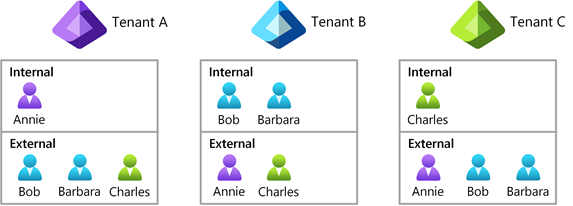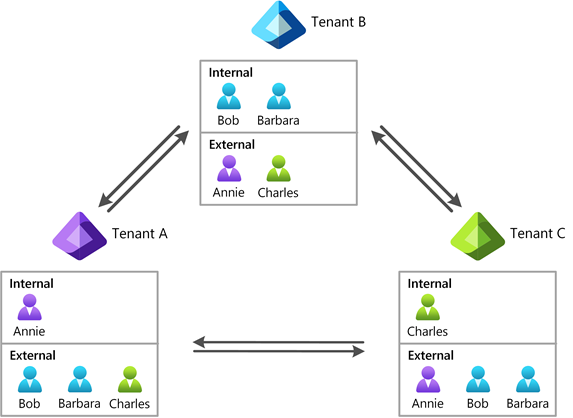Multitenant organization identity provisioning for Microsoft 365
The multitenant organization capability is designed for organizations that own multiple Microsoft Entra tenants and want to streamline intra-organization cross-tenant collaboration in Microsoft 365. It's built on the premise of reciprocal provisioning of B2B member users across multitenant organization tenants.
Microsoft 365 people search
Teams external access and Teams shared channels excluded, Microsoft 365 people search is typically scoped to within local tenant boundaries. In multitenant organizations with increased need for cross-tenant coworker collaboration, it's recommended to reciprocally provision users from their home tenants into the resource tenants of collaborating coworkers.
New Microsoft Teams
The new Microsoft Teams experience improves upon Microsoft 365 people search and Teams external access for a unified seamless collaboration experience. For this improved experience to light up, the multitenant organization representation in Microsoft Entra ID is required and collaborating users shall be provisioned as B2B members. For more information, see Announcing more seamless collaboration in Microsoft Teams for multitenant organizations.
Collaborating user set
Collaboration in Microsoft 365 is built on the premise of reciprocal provisioning of B2B identities across multitenant organization tenants.
For example, say Annie in tenant A, Bob and Barbara in tenant B, and Charlie in tenant C want to collaborate. Conceptually, these four users represent a collaborating user set of four internal identities across three tenants.
For people search to succeed, while scoped to local tenant boundaries, the entire collaborating user set must be represented within the scope of each multitenant organization tenant A, B, and C, in the form of either internal or B2B identities.
Depending on your organization's needs, the collaborating user set may contain a subset of collaborating employees, or eventually all employees.
Sharing your users
One of the simpler ways to achieve a collaborating user set in each multitenant organization tenant is for each tenant administrator to define their user contribution and synchronization them outbound. Tenant administrators on the receiving end should accept the shared users inbound.
- Administrator A contributes or shares Annie
- Administrator B contributes or shares Bob and Barbara
- Administrator C contributes or shares Charles
Microsoft 365 admin center facilitates orchestration of such a collaborating user set across multitenant organization tenants. For more information, see Synchronize users in multitenant organizations in Microsoft 365.
Alternatively, pair-wise configuration of inbound and outbound cross-tenant synchronization can be used to orchestrate such collating user set across multitenant organization tenants. For more information, see What is a cross-tenant synchronization.
B2B member users
To ensure a seamless collaboration experience across the multitenant organization in new Microsoft Teams, B2B identities are provisioned as B2B users of Member userType.
| User synchronization method | Default userType property |
|---|---|
| Synchronize users in multitenant organizations in Microsoft 365 | Member Remains Guest, if the B2B identity already existed as Guest |
| Cross-tenant synchronization in Microsoft Entra ID | Member Remains Guest, if the B2B identity already existed as Guest |
From a security perspective, you should review the default permissions granted to B2B member users. For more information, see Compare member and guest default permissions.
To change the userType from Guest to Member (or vice versa), a source tenant administrator can amend the attribute mappings, or a target tenant administrator can change the userType if the property is not recurringly synchronized.
Unsharing your users
To unshare users, you deprovision users by using the user deprovisioning capabilities available in Microsoft Entra cross-tenant synchronization. By default, when provisioning scope is reduced while a synchronization job is running, users fall out of scope and are soft deleted, unless Target Object Actions for Delete is disabled. For more information, see Deprovisioning and Define who is in scope for provisioning.


